At 9 a.m. on a Wednesday morning, traffic is steady along Adanac Street near Boundary Road as drivers head across the Adanac overpass, which crosses over Highway 1. The route is popular with neighbourhood residents as well as those looking for a shortcut to avoid Hastings Street or East First Avenue.
Adanac Street is also a bike route.
But drivers accustomed to using it will have to rethink their travels come spring.
The City of Vancouver is closing the overpass, from Highway 1 to Cassiar, to private vehicles to avoid potential congestion once Fortis B.C. begins upgrading an underground gas line running between Coquitlam and Vancouver. That work will create temporary lane closures and temporary full street closures of East First Avenue in sections. It’s believed more drivers would use the Adanac overpass as a short cut once that work starts, creating even higher volumes of traffic in the residential neighbourhood.
Buses, cyclist, emergency vehicles and pedestrians, however, will still have access.
The closure is being described as temporary, although the city acknowledges in a Jan. 2 letter to residents that it could be permanent “if it proves to help address neighbourhood concerns regarding the volume of non-local motor vehicle traffic in the area.”
Some residents aren’t happy about the decision either way, including Michael Manale. He found out about it from a neighbour.
Manale agrees the route is busy, and said he’s particularly concerned about drivers travelling above the speed limit, but he argues closing the overpass isn’t the answer — enforcing traffic rules and adding traffic calming measures is.
“There are many things to do other than to close the overpass. There are ways to make it less convenient for people to cut through the neighbourhood — a four-way stop at every intersection, speed bumps that you actually have to slow down for,” he told the Courier during an interview at the corner of Adanac and Cassiar Jan. 10 while he was out walking his dog, Dora.
“And, if First is going to be closed for this Fortis gas project, then it gives the police one main artery to focus on. It’d be where they could spend more attention with people obviously not going 30 in a 30 zone.”
Manale, who lives east of the overpass, argues the closure will have a significant and negative impact on local drivers who use it to get in and out of the neighbourhood. Hastings Street, he explained, is already congested at morning and evening rush hours and it’s almost impossible to turn on to when there is an accident or stall on the Second Narrows Bridge. Once Fortis B.C. starts work on East First, the other main option, aside from Hastings, is for drivers to head south all the way to Broadway.
“I’ll speak for everyone in our area — we would all like to see something done about the speeds but the option of having the bridge totally closed for us is far worse of an inconvenience,” he said.

Meanwhile, a group of concerned residents, including Lara Davis, circulated a letter about the city’s plan on Dec. 6. The letter indicates they weren’t aware of anyone receiving city notice about the pending closure and that they planned to get in touch with city officials. The letter argues the closure will put additional pressure on streets east of Highway 1, including what they describe as the “already dangerous” intersection at Skeena and Adanac where children cross for school.
“It will also eliminate our neighbourhood car access across the overpass to the area west of Highway 1,” it adds.
Davis told the Courier that 1,500 households will be affected east of Highway 1. Her group has heard from just under 400 after dropping flyers off at homes, the majority of whom are unhappy or have expressed concerns about the planned closure.
Vancouver resident Mavis Roed also forwarded the Courier a letter she and her husband sent to the City of Vancouver, which argues the closure will affect both Vancouver and Burnaby residents and it will jam up Hastings and First Avenue “more than they already are.” Neither she nor her husband ride bikes, or plan to do so, and only take transit periodically.
“We love our city. Let’s not make it any harder to get around in it than it already is,” she wrote.
Manale, meanwhile, isn’t convinced traffic concerns are the reason behind the closure of the overpass. He’s heard the city wants to reduce vehicle use to extend the structure’s life so it won’t need an expensive upgrade as soon.
Lon LaClaire, the city’s director of transportation, told the Courier it’s a relatively new bridge, which was built in the early 1990s, and he wasn’t aware of any structural concerns about the overpass. (A subsequent email from the city’s communication department indicated that, because it’s a freeway overpass, it’s not a city asset: “…it’s a provincial asset and they would maintain it, but our understanding is that it is in good condition.”)
In any case, independent of the Fortis upgrade issue, the city was already looking into traffic patterns in the area after residents raised concerns, according to LaClaire.
A public engagement process about those problems was launched last May, focusing on the area between Hastings Street, Boundary Road, East First Avenue and Renfrew Street.
The study found the biggest problem is high volumes of non-local motor vehicle traffic using local streets, particularly near schools, to access the Adanac overpass over Highway 1.
Traffic analysis revealed 71 per cent of vehicles travelling westbound over the Adanac overpass during morning rush hours and 73 per cent of vehicles heading eastbound during evening rush hours is non-local commuter traffic.
“We were out in the community talking about transportation problems back in early (2017). It was identified by the neighbourhood as a concern. When the proposed work on Frist Avenue came up, we developed this [overpass closure] strategy,” LaClaire said. “It’s related in the sense that the issues and concerns of the neighbourhood had been identified to us.”
He added that the idea of closing the overpass was a request from the neighbourhood.
“With the closure of First Avenue as part of this utility work, we have a serious concern with the amount of traffic that will be cutting through the neighbourhood, so this is an appropriate response to that. We do these types of more significant interventions whenever big arterial projects are underway,” he said.
“…We’re going to do it because it’s the correct course of action for this work. However, it is a convenient way to trial it.”
The closure will be in place at least a month before the Fortis work starts on East First Avenue, which is expected to begin in the spring, so the traffic pattern is properly established. The utility work will probably take about four or five months and LaClaire said the city will probably keep the overpass closure in place for a month afterwards.
“And then, at that point, it’s the perfect time for us to survey the neighbourhood. If they want to keep it, it’s something we would keep. If they don’t want to keep it, we would take it out. To be clear, it’s the neighbourhood that it’s benefiting — people who want quiet streets, a nice quiet neighbourhood, this will help achieve that.”
LaClaire also said he’s personally received about 14 emails from residents about the plan recently, which were evenly split on the issue. Mixed responses are typical when the city deals with traffic calming measures, he added.
Over the last month, the city has received about 20 emails a week, prior to the Jan. 2 letter to residents going out. Following the delivery of the letter, the city received about 50 emails.
(According to an update from the city's communication department Thursday evening, calls the city has received from people who live in the area tend to be supportive, with the exception of groups who live east of the freeway who have expressed concern over the inconvenience caused by the closure.)



